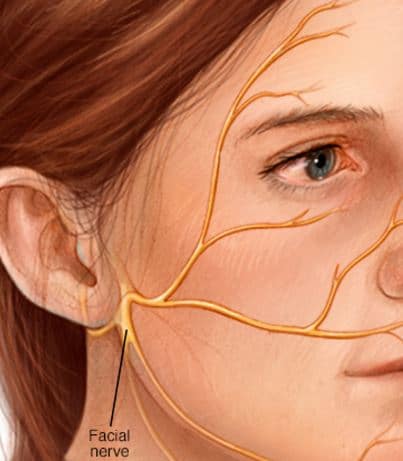Previous posts have talked about collisions and traffic jams in and around the tiny tunnel that hooks the inner ear to the brain via the auditory (vestibulocochlear) nerve. Anything that interferes with that anatomy can cause unilateral hearing loss and other balance or hearing conditions. Besides benign tumors pressing on the nerve, we’ve described vascular loops. Today is the second post in a series on shingles.
Unlike invisible, painless vascular loops or acoustic neuromas, Shingles is VERY visible and VERY painful (see feature image). Whereas vascular loops may be normal anomalies (perhaps from birth?), Shingles is a disease. It attacks normal body systems and the body responds by literally erupting in pain.
Where Is Shingles in the Auditory System?
The latent varicella zoster virus hides in the roots of the vestibulocochlear nerve. When the virus is reactivated it becomes shingles (herpes zoster). Although shingles looks like a bad skin rash — and it is — the rash is actually a manifestation of a central nervous system disease. The rash “follows” the nerve. In the case of shingles of the ear, it’s probably following both the auditory and the facial nerves, so you’ll see the rash on the ear and down the side of the face, headed toward the mouth.
That explains why, when shingles emerges in the auditory system, it almost always affects only one ear — the one surrounded by the rash, as shown in the feature image. Besides intense and severe pain in and around the ear, other symptoms can occur, such as:
- Decreased hearing
- Tinnitus
- Vertigo
- Nausea or vomiting
What Determines The Other Symptoms?
When the varicella zoster virus reactivates into Shingles, it has a choice of nerve paths to follow. That’s not surprising when you consider how tightly packed the various nerves are in the internal auditory canal. The virus can follow the facial nerve, the cochlear nerve, the vestibular nerve or some combination of the three. Two common paths and pathologies are:
- Labyrinthitis. This term refers to infection and swelling in inner ear structures that affect balance as well as hearing. Shingles can cause labyrinthitis either through direct viral infection or by subsequent bacterial infection that occurs as the blisters crust over and begin to heal.
- Ramsay Hunt Syndrome. This condition, also known as herpes zoster oticus, occurs when the varicella zoster virus spreads into the facial nerve near the inner ear. This causes nerve damage that affects your hearing.
In rare instances, the virus is more widespread, involving other cranial nerves (e.g., glossopharyngeal and vagus) in addition to the vestibulocochlear and facial nerves. It is difficult to imagine the pain in that situation. (Editor’s Note: One of the HHTM editors had Ramsay Hunt in the left ear/face in 2007 and will never forget the pain).
Ramsay Hunt is a big deal for those that suffer through it and for their attending Audiologists. It deserves its own whole post, which will be the third post in the Shingles Series.
feature image from Mayo Clinic






